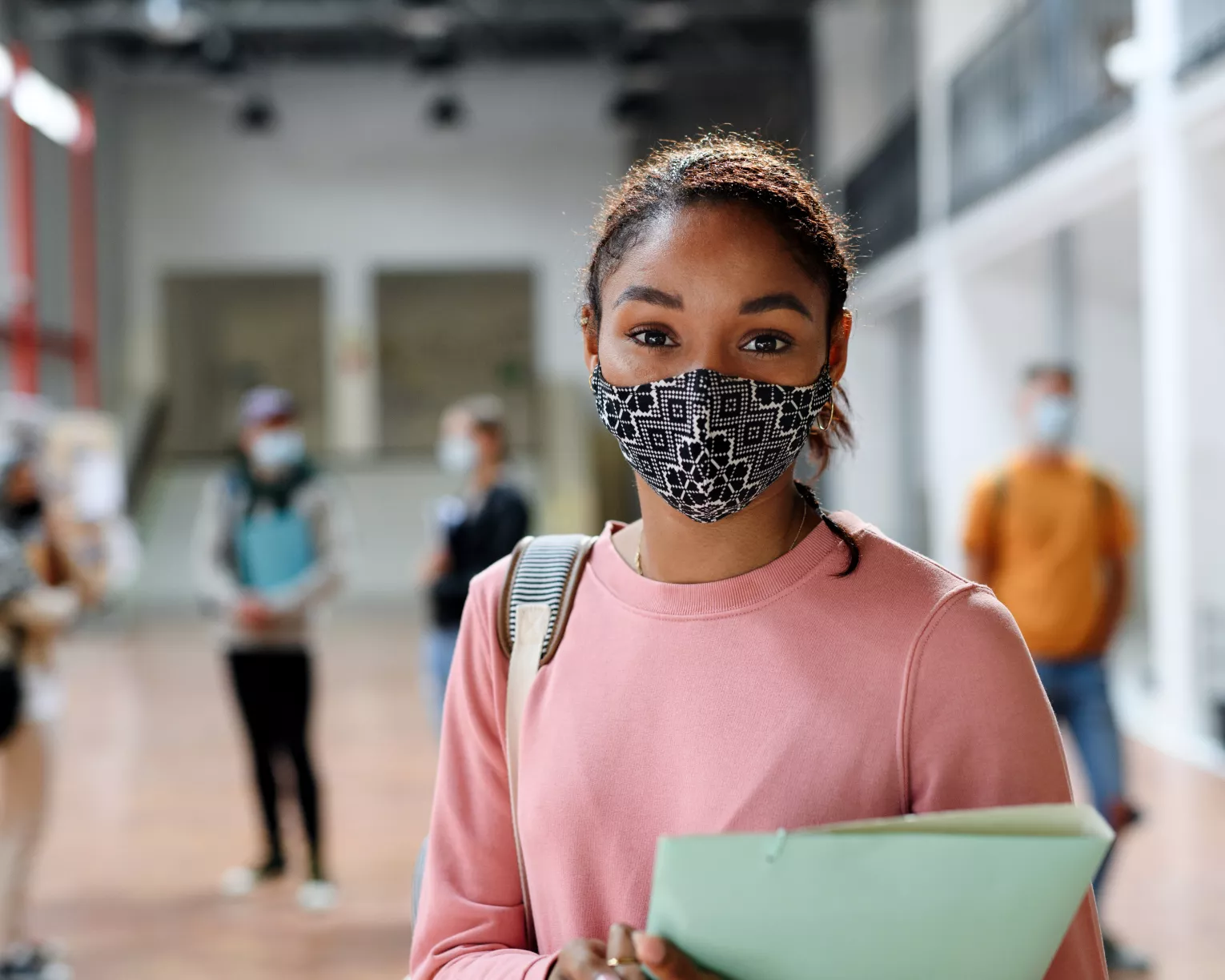Bargaining for the Common Good: Sample Demands for Safe and Just In-Person Learning
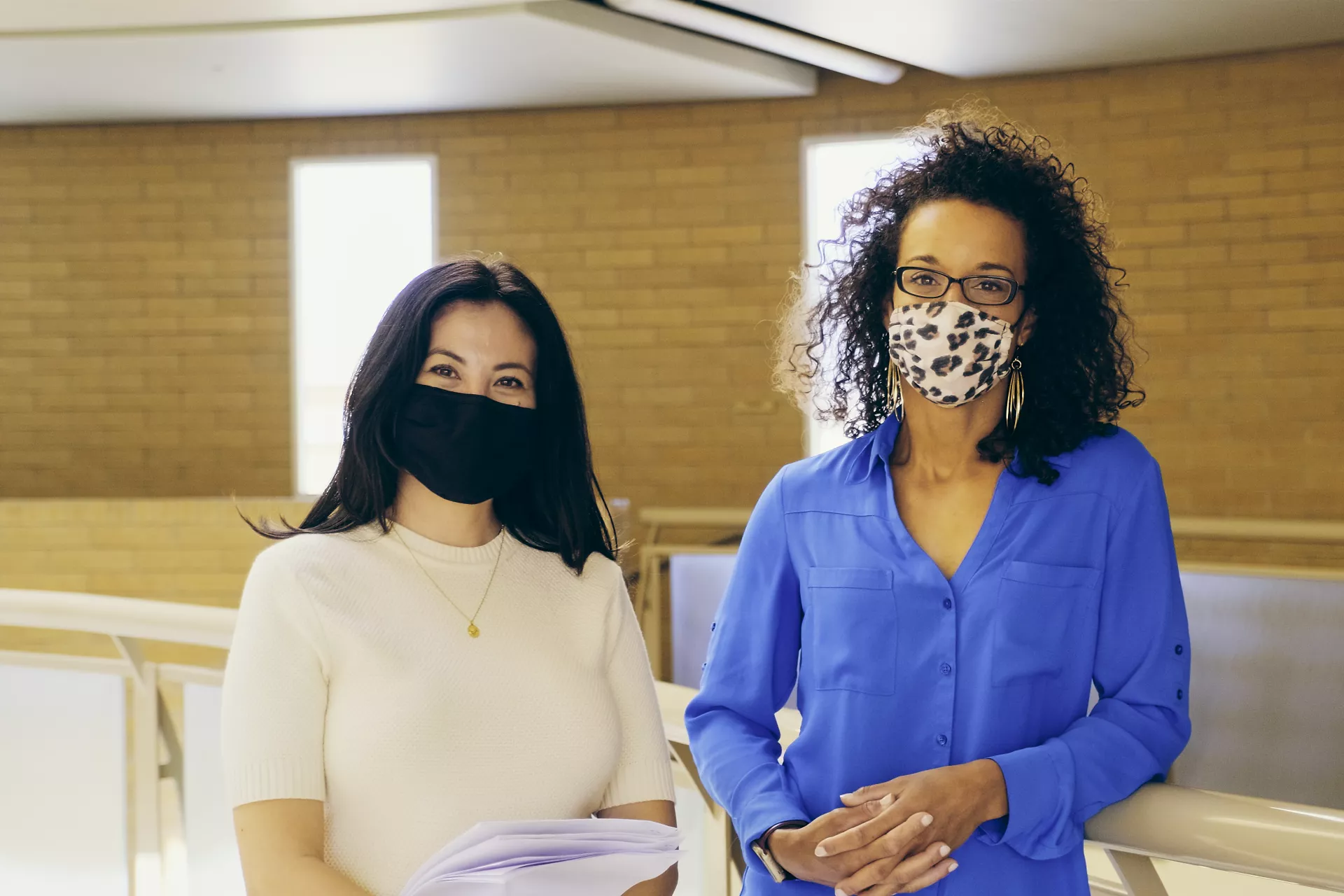
No one understands the importance of in-person learning more than educators and parents.
After all, we see first-hand what students are going through. We are also responsible for safeguarding the health and safety of our students and school communities. And, we have a responsibility to ensure reopening school buildings and campuses addresses longstanding inequities rather than compound them.
Use these Bargaining for the Common Good sample demands to advocate for the health and safety of students, educators, and families.
Sample Health and Safety Demands
Here are criteria that your community can put in place to ensure the health and safety of students, educators, and families when returning to in-person instruction.
The COVID-19 pandemic is under control in your community.
Use metrics to determine when and how to provide in-person instruction. Ensure they are at least as protective as those used in the K-12 guidance by the U.S. Centers for Disease Control and Prevention (CDC): total new cases per 100,000 persons in the past 7 days and the percentage of positive diagnostic and screening viral tests that are nucleic acid amplification tests (NAATs).
Specific protections to keep the virus under control and protect students and staff.
COVID-19 Vaccines: Educators of all types, including teachers, education support professionals, and specialized instructional support personnel, have the option to get vaccinated. Employer provides paid leave for employees to get vaccinated.
Detection: Procedures are in place to detect COVID-19 cases among students, staff, and visitors, including education on symptoms, requiring those who are sick to stay home, isolation of symptomatic individuals, and closing some or all school buildings to contain potential outbreaks. Frequent, robust, and equitable COVID-19 testing screening must be in place.
Accommodations: High-risk students, staff, and families are protected through appropriate accommodations such as remote learning and instruction arrangements.
Mitigation: Strong mitigation measures have been put in place, including:
- A requirement that everyone wear appropriate face coverings, including N95 respirators for staff having close contact with students, and that the employer provide those face coverings and respirators.
- A requirement that students, staff, and visitors wash their hands for 20 seconds several times a day and, where doing so is not possible, are provided with hand-sanitizer of at least 60% alcohol.
- Plexiglass protections installed where necessary to address droplet transmission.
- Heating, ventilating, and air-conditioning (HVAC) systems inspected and, if necessary, modified to increase air flow, air filtration, and the circulation of clean air while adjusting environmental conditions like temperature and humidity. Windows, doors, fans, and other methods of addressing indoor air quality (IAQ) – including portable high-efficiency particulate (HEPA) filters – must also be considered. Areas that cannot be properly ventilated should not be occupied.
- Sufficient classroom supplies and consumables are provided so each student has their own.
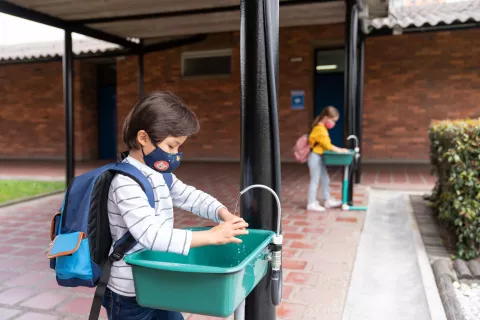
Distancing: All necessary steps have been taken to maintain appropriate physical distance among all students, staff, and visitors throughout the day including, where necessary, class size reductions, reconfiguring classrooms, and readjusting school schedules and traffic patterns. Safe school-sponsored transportation must also be provided including reconfiguring school buses and transportation schedules to allow for distancing.
Cleaning and Disinfection: Thorough protocols are in place for appropriate cleaning and disinfecting of school and campus facilities and buses, as well as more frequent cleaning and disinfection of high-touch surfaces and frequently used areas such as restrooms. Protocols must ensure that over-disinfection and unnecessarily harsh chemicals are not used and staff have been trained and provided the necessary personal protective equipment (PPE) to perform the cleaning and disinfecting tasks safely.
Quarantine, Isolation and Notification Procedures: Triggers for school/campus closures to in-person instruction are clear to families and staff. A protocol is in place that provides for notification of individuals exposed in school to someone with COVID-19, for immediate isolation of that person in appropriately ventilated isolation rooms, and quarantines of those who have been exposed. Paid leave for those who cannot work due to COVID-19 illness. Robust plans exist for continuity of instruction through substitutes or other instruction when teachers or professors must quarantine or when in-person instruction must be closed. During any such closure, continuity of instruction, nutrition, and support services for all students must be provided.
Educator and Family Involvement: Procedures are in place to ensure educators and families have a voice in how the return to in-person instruction occurs and how necessary protections function throughout the school year. Potential avenues for educator and family input include district- and building-level health and safety committees and, where possible, collective bargaining.
Monitoring: Health and safety protections are independently enforced through regular, unannounced building inspections by local health and labor department authorities and a widely publicized hotline to report violations. Whistleblowers must be protected against any and all retaliation or adverse actions.
Enforcement: Clear policies are established for how protective measures will be enforced consistently, ensuring disparate discipline of students or staff does not occur. All federal, state and local laws and regulations for worker safety and health, infection control, and environmental protection must be met or exceeded.
Racial and Social Equity: Analysis and planning have taken place to ensure that equitable health and safety protocols are adopted and that resources are distributed equitably.
Plans to ensure continuous learning for all students.
- There is a plan for instruction (whether in-person or virtual) that addresses racial and social equity in the provision of instruction and support services.
- The plan includes training for educators, families, and students on the processes and protocols in the event a COVID-19 outbreak necessitates returning, in whole or in part, to virtual instruction.
- Educators are involved at each step of the planning process for any form of virtual teaching and learning, including adjusting the curriculum and methods of instruction.
- The plan for continuous learning addresses device access for every student, high-speed internet access for every student and educator, and accommodates gaps in such services. This should include adaptive equipment for staff, students, and students’ families with disabilities.
Sample K-12 Demands
Below are sample Bargaining for the Common Good demands for safely returning to in-person instruction. They can be helpful as you organize, plan, and negotiate the return to school buildings and campuses.
Public Health and Safety
- Plans for in-person instruction must involve all stakeholders in order to ensure the safety of students, educators, and communities.
- Continue remote learning for as long as necessary to ensure the health of students and staff.
- Fair, clear, and consistent expectations across districts related to COVID-19 mitigation strategies.
- Provide school leaders with clear guidance to establish procedures if students or staff become unwell. Guidance should include monitoring student and staff health, maintaining regular contact with local health authorities, and updating emergency plans and contact lists.
- Follow available guidance from the CDC on maximum gathering sizes and personal protective equipment.
- Provide educators and staff access to PPE and disinfectant items as well as sufficient training and clear guidelines for students and staff on how and when to use them safely and properly.
- Ensure that reliable, widespread COVID-19 testing, vaccination availability, effective tracing and social distancing have been used in the communities that are considering reopening their public schools for in-person learning.
- Ongoing, open communication with all stakeholders must continue.
Academic Success
- Hybrid delivery of instruction available – continued delivery of instruction no matter what.
- Seek policy waivers on number of student days, length of day, length of year, to allow for hybrid models or split scheduling for schools to ensure smaller class sizes and social distancing.
- Abeyance of all standardized tests.
- Additional availability of trained substitute teachers.
- Create a multi-language communication plan for all stakeholders and include parent/community input.
- Suspend requirements for fire drills, active shooter drills, and other planned emergency drills that disrupt student learning and could lead to large gatherings of students and staff.
- Modify attendance requirements so that students are held to the expectation of completing their work – not necessarily to “checking in” to class every day.
- Hold harmless arts and elective classes from funding cuts.
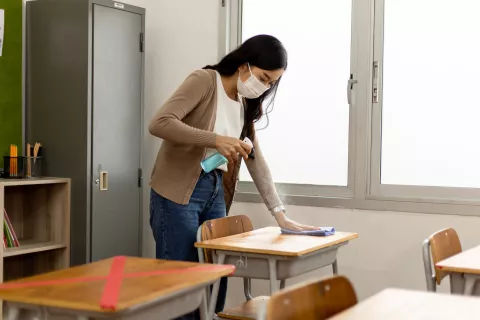
Equity
- Support in providing educational opportunities for special populations of students including students with disabilities, English learners, migrant students, those who are medically fragile, and students experiencing homelessness.
- Increase investment in special education accommodations, such as IEPs and 504 plans.
- Bring back small groups of special education students for in-person learning before other students to give them extra attention and time.
- Utilize technology for occupational therapists and speech pathologists through distance learning or other mechanisms if available.
- Allow amendments to IEPs through distance learning plans.
- Reduce amount of work required for students who are easily overwhelmed.
- Design all online learning so it is accessible to students who may need larger font and/or more explanations to ensure success for all students, not just those with special needs.
- Establish a mechanism to communicate with non-English speaking parents and guardians to provide more access to up-to-date information.
- Create a system for providing food-insecure students with school meals, either through meal delivery or vouchers for grocery stores or restaurants.
Social and Emotional Well-Being
- Ensure all services are culturally responsive and include access to community-based providers/programs.
- Establish trauma training at the start of school year (and ongoing) to help to identify trauma in students.
- Expand crisis teams to every school building to monitor and assist with social/emotional health.
- Extend re-entry for students with a focus on social and emotional impacts of COVID-19 to prepare students for learning.
- Increase staffing of specialized instructional support personnel.
- Ensure mental health professionals are able to perform their job function instead of working on administrative duties.
- Partner with local medical and mental health professionals to provide full range of services for students.
- Track long-term effects of pandemic on students including changes in grades, test scores, graduation rates, and absenteeism.
- Prioritize stress counseling.
Safe Working and Learning Conditions
- Provide sufficient funding for PPE for all staff and students.
- Extend and clarify paid leave provisions under state/federal law.
- Compensate all educators – full-time, part-time, hourly, and per diem workers, including teachers, secretaries, paraeducators, food service, transportation, and substitutes –during this time.
- Ensure employees are not required to use personal devices to conduct classes.
- Seek employee feedback about various digital platforms used to provide instruction to students including, but not limited to, ease of use, security, student interaction, and participation.
- Utilize COVID-19 response as an opportunity to review policies on use of school facilities during emergencies.
- Publicize state, district, and school plans in time for educators to prepare adequately.
- Assess teacher and staff workload to avoid burnout and ensure the work is distributed equitably and staff shortages are addressed to increase capacity as necessary.
- Declare a moratorium on all educator evaluations.
Investments in Schools
- Identify response and recovery financing for immediate investments in school water, sanitation, and hygiene.
- Direct education funding to schools and communities hit hardest by the crisis.
- Close the technological gap by providing as many devices as possible to all students.
- Waive school fees and other costs wherever possible and eliminate other barriers to entry.
- Ensure that educators have professional pay and healthcare benefits and fight against privatization of educators’ jobs.
- Suspend all state funding of private schools that do not meet public school guidelines for safe and effective delivery of instruction.
Racial Justice
- Acknowledge the pandemic was not experienced equally by all communities and populations, particularly in rural areas and communities of color. Listen and learn how different families handled the time out of school buildings.
- Provide and prioritize housing, food, health, dental, and job services in neighborhood schools because it is a common-sense way to begin to address these issues and the racial inequities they create and exacerbate.
- End attempts to funnel resources away from public schools and re-segregate our school communities with charters, vouchers, and other privatization schemes.
- Ensure school plans for in-person instruction are inclusive and equitable for all educators and students by humanizing learning environments and designing spaces that are situated in the experiences of communities of color, not just through white, cis-hetero, and ableist lenses.
- Ensure adequate time is provided for classroom-community-building activities and consider the paid time and additional staff to allow for the development of restorative practices in schools.
- Prioritize hiring, retaining, and promoting educators of color.
Sample Higher Education Demands
These demands are largely taken from the great work of the United Faculty of Florida / Florida Education Association, the Massachusetts Teachers Association and the California Teachers Association, all of which actively organize and represent higher education members.
Social and Emotional Well-Being
- Reduce student and parent anxiety by providing clear information to students and families as to the safety of re-opening campuses.
- Prioritize existing mental health programs and staff (rather than outside consultants) and respect their expertise in developing protocols and triage care.
- Provide a single webpage for students and parents, and another for faculty and staff, that list all online resources that would be different than normal, including: Mental health resources; Current information with the source of recommendations, who made them, and when they were made; Reassurance to students and staff about the physical space such as new protocols for cleaning, access, etc. that will make people more confident that they are safe
- Reach out to student groups so they know how to access and share resources
-
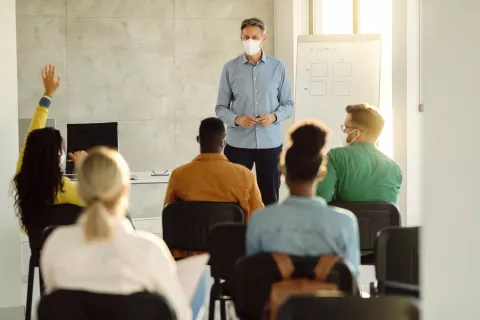
Ensure International Association of Counseling Services (IACS)-recommended ratio student-to-mental health professional of 1:1499 FTE.
- Ensure mental health counselors are available online and assist counselors in reaching out to students with technological barriers.
- Include student and faculty/staff groups in decision-making and in the dissemination of information.
- Provide clear information about accessing mental health resources included in all communication (emails, texts, websites, online learning resources/classrooms, etc.).
- Conduct mental health assessments or surveys by app or other methods to get a feeling for anxiety levels of the students, faculty, and staff.
- Create mental health assessment or surveys to get a feeling for anxiety levels of the students, faculty, and staff.
- Provide extra resources for vulnerable populations: (LGBTQ, international, low-income, minority, housing-insecure students).
- Train administration and faculty in the use of a trauma-informed approach to dealing with the reopening of campus, including reducing stigma for those who have been quarantined, contracted the virus, and/or who have been caregivers.
- Create a method for students, faculty, and staff to report issues without fear of reprisal.
- Create spaces on campus for grieving and healing.
- Bring students on campus early to reacquaint and reconnect them if conditions are safe.
- Engage student leaders and communications staff to create materials to direct people to the new normal.
- Provide staff and faculty with training on how to identify students struggling with anxiety and/or trauma and how to refer them to mental health professionals for support.
- Allow housing-insecure students and those who cannot return home to stay on campus. Work with local landlords to arrange forgiveness of rent payments for students who leave off-campus housing.
- Make provisions for feeding food-insecure students.
Student Success
- Provide expanded access to broadband and technology to close the “digital divide.” Identify students who lack sufficient access to the internet and the hardware that has become critical to learning, and determine solutions for equal access (i.e., checked out or loaner computers, hard drives, broadband access, etc.).
- Waive internet access fee for students.
- Upscale Student Assistance Programs to include all previous needs as well as pandemic needs. They must be easily found and accessible.
- Provide increased Americans with Disabilities Act (ADA) and Section 504 of the Rehabilitation Act support (ASL interpreters, physical and technological needs of the visually impaired, etc. available for all course modalities). Purchase excellent captioning software – and end the reliance on YouTube, Google, and other programs not specific to captioning, as they are not accurate enough and are a disservice to our students.
- Supply face shields and/or clear masks for American Sign Language ASL interpreters and staff who interact with hearing-impaired students.
- Provide specific guidance from national accrediting institutions for programs that focus on practicum and/or clinical applications will need to ensure students can complete program requirements.
- Hire more staff to ensure Student Assistance Programs are available when students need them with no wait times.
- Provide extra tutoring services for struggling students.
- Campus administrations must provide easily accessible resources to assist faculty with the transition to temporary remote teaching.
- Give students who live in poverty, working students and students of color the support, resources and funds they need to safely stay in school. When campuses reopen, all students should be safe and have access to the same quality of education, including poor, working, Black and brown students.
Safe Learning and Working Conditions
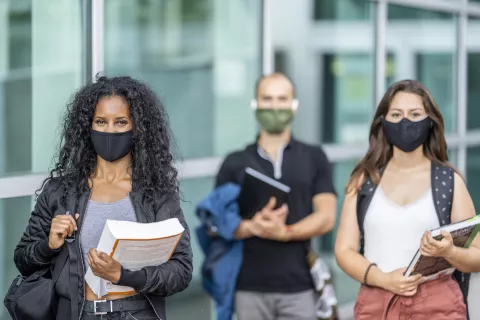
- Preserve higher education as a provider of good, family-supporting jobs by providing PPE and keeping everyone on the payroll.
- Define health requirement for clearance to return to campus, such as recent negative tests.
- Provide access to healthcare and free testing for all employees.
- Create test and trace mechanisms.
- Create clear protocols for notifying public health officials, students, staff, and faculty of positive COVID-19 cases.
- Reduce class sizes to ensure social distancing.
- Promote a method for faculty and staff to report health, safety, and academic issues related to the pandemic without fear of reprisal.
- Create a clear policy (respecting HIPAA) for identifying high-risk students and employees.
- Provide flexible use of paid sick leave that does not come out of accrued sick leave. The institution can fund this from the American Rescue Plan, such as utilizing ESSER and ESSER II funds, and other pandemic relief funds or employers should provide extensions either voluntary or through collective bargaining. No negative repercussions will occur for sick leave when required by policies and/or advised by medical professionals.
- Clear protocols for class cancellation, substitution, or relocation due to symptoms or confirmed exposure and/or how those classes will be covered/made up. Whatever conditions are created must be uniform across departments and colleges within the same institution.
- Include adjunct faculty in healthcare and sick leave plans, and in testing programs.
- Provide documentation and support for adjuncts to be able to access pandemic unemployment insurance, and to traditional unemployment insurance.
- Hire more maintenance staff due to increased need for cleaning and disinfecting. Do not require non-maintenance personnel (staff, faculty) to be responsible for implementing cleaning protocols.
- Limit campus access to non-students and non-employees.
- Train staff on use and storage of new chemicals, including interactions.
- Immediately pass legislation providing access to health insurance for adjunct faculty.
- Recognize the importance of maintaining safe learning opportunities for the benefit of the students and communities served by the college or university and its faculty.
- Guarantee that all higher education workers are paid, including adjunct and visiting faculty, tutors, students, graduate students, and contracted and per-diem employees.
Educator Rights
- Suspend all evaluations. Otherwise, evaluations must acknowledge the unusual circumstances of this year. No one should be penalized for canceled conferences, work that is suspended for public health reasons, or teaching evaluations that may be adversely affected. Faculty should be assured that these disruptions will not affect their evaluations, tenure, promotion, or contract renewal decisions now or in the future.
- Campus administrations must provide easily accessible resources to assist faculty with the transition to temporary remote teaching.
- Provide computers, webcams, high-speed internet access, etc. for all instructional personnel or create an easy and quick reimbursement stipend. These must be provided just as classroom space or equipment would normally be provided for on-campus class meetings.
- Faculty should get credit for their additional efforts these semesters as they do the work to create remote teaching and learning systems, including covering other colleagues’ work if necessary.
Safe and Equitable Protections for All Working People and Our Most Vulnerable Populations
Everyone deserves the right to a safe, healthy workplace and learning environment. We can come together across race and across place to ensure we are all treated with dignity and respect. Educators can unite with other unions, workers, and communities to demand justice.
Community Health and Safety
- Deploy support teams uniting public health, social services, food and agriculture, housing and community development, aging, and business agencies.
- Develop culturally- and linguistically-accessible communications and resources for diverse communities.
- Address barriers to testing and treatment including availability and costs.
- Train bilingual, bicultural contact tracers and case investigators.
- Childcare for first responders and healthcare personnel, nutrition program for students, and other social services necessary to preserve and maintain life, health, property, or the public peace.
- Provide a weekly disaster stipend for working parents to stay home with their children without losing pay.
- Learn about the specific needs of Indigenous people, Black and brown people, LGBTQ relatives, educators, freelancers, undocumented and documented immigrants, and low-income workers, and work towards answering these needs as rapidly as possible.
- Recognize all workers on the front line during the COVID-19 crisis, such as grocery store workers, postal service workers, and educators, through a substantial increase in wages and benefits.
Social Safety Net
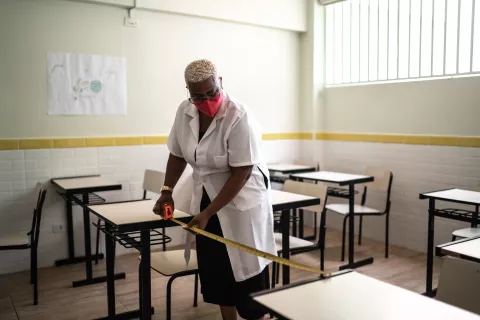
- Call on state and federal government officials to immediately release funds to support our vulnerable student and family populations.
- Demand that city, county, and state officials create a healthy, socio-economic safety net for our students, working families and communities.
- Extend unemployment insurance for people whose hours are reduced due to COVID-19 and a basic income subsidy to those workers not covered by unemployment laws.
- Provide funding for universal childcare as we navigate the reopening of schools in the midst of the pandemic.
Housing and Homelessness
- Advocate for debt forgiveness, suspended rent and mortgage payments, as well as eviction court and utility shutoffs.
- Provide safe shelter, healthcare services and support for all, including students, who are suffering from homelessness.
- Open up school facilities (i.e., washrooms, locker rooms, computer labs, libraries, and gyms) before and after school hours for student use.
- Provide washers and dryers for student use.
- Hire additional staff whose responsibilities include finding and re-engaging homeless students and connecting them to services like housing, food assistance, and child care.
- Provide professional development focused on identifying and educating homeless students to all educators.
- Purchase pre-paid cell phones to keep homeless families connected to the school community.
- Utilize school vehicles to conduct outreach and supply drops to local motels, campgrounds, food banks, and homes with doubled-up students.
- Hire additional school counselors to assist students with credit recovery, graduation, and college transition.
- Hire additional school psychologists to screen for and address trauma.
- Provide professional development to all educators on trauma-informed training.
Healthcare and Paid Sick Leave
- Remove of all economic barriers for COVID-19 testing and treatment, including eliminating all insurance co-payments and deductibles.
- Require paid family and medical leave for all workers, including municipal workers, either through their employer or a state system, to cover any needed self-quarantining to reduce the spread of the virus.
- Provide additional paid sick days each year to all workers to align with quarantine period for COVID-19; additional paid time off for those who do not have paid sick days with their employers.
Undocumented/Immigrant Justice
- Create an economic relief fund specifically for undocumented residents excluded from federal stimulus.
- Cease ICE arrests/deportations; release vulnerable populations, demilitarizing and decarcerating non-violent offenders and political prisoners from jails, prisons, and detention centers.
- Ensure that undocumented individuals are included in any universal basic income distribution with added support for path to citizenship.
References
Are you an affiliate?
